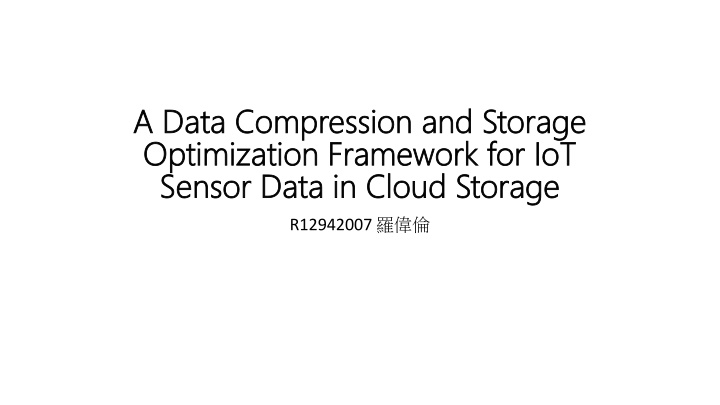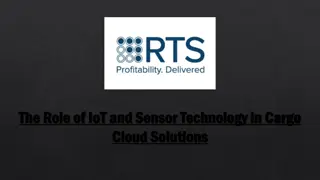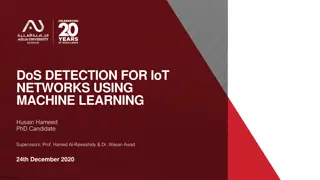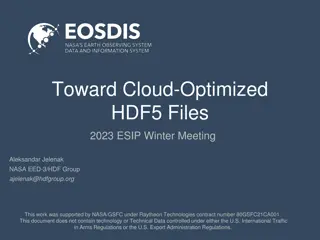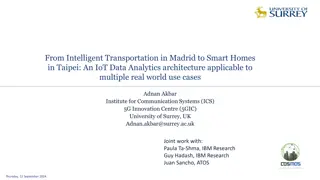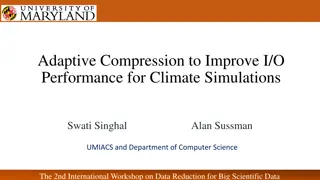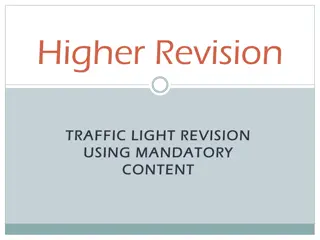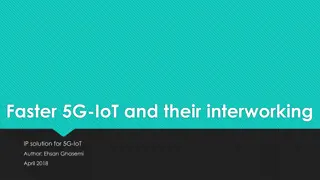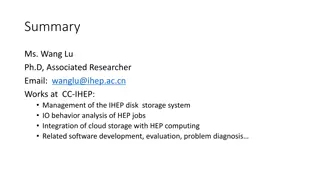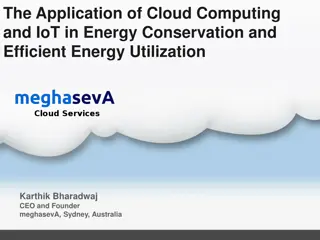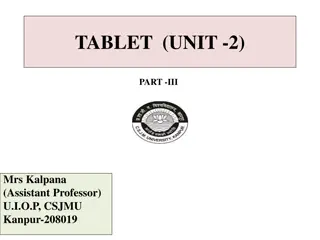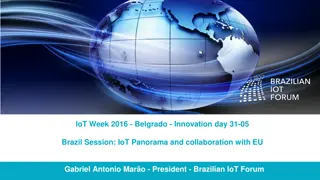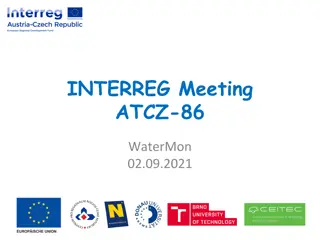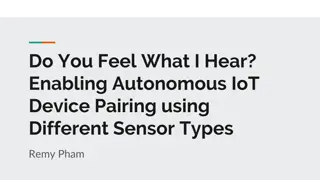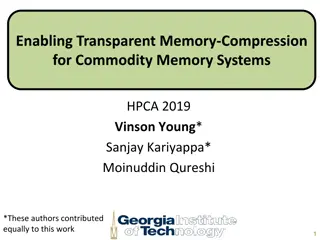Data Compression Framework for IoT Sensor Data in Cloud Storage
Presenting a multi-layered data compression framework tailored for IoT sensor data storage in the cloud, focusing on reducing data volume efficiently while maintaining low error rates. Explore the integration of IoT with cloud computing, offering virtually unlimited storage and processing capabilities. Learn about lossless and lossy compression techniques, with insights into Fog Computing to optimize energy consumption during data transmission.
Uploaded on Mar 04, 2025 | 1 Views
Download Presentation

Please find below an Image/Link to download the presentation.
The content on the website is provided AS IS for your information and personal use only. It may not be sold, licensed, or shared on other websites without obtaining consent from the author.If you encounter any issues during the download, it is possible that the publisher has removed the file from their server.
You are allowed to download the files provided on this website for personal or commercial use, subject to the condition that they are used lawfully. All files are the property of their respective owners.
The content on the website is provided AS IS for your information and personal use only. It may not be sold, licensed, or shared on other websites without obtaining consent from the author.
E N D
Presentation Transcript
A Data Compression and Storage A Data Compression and Storage Optimization Framework for IoT Optimization Framework for IoT Sensor Data in Cloud Storage Sensor Data in Cloud Storage R12942007
Outline Outline 1. Abstract 2. INTRODUCTION 3. BACKGROUND OVERVIEW 4. METHODOLOGY 5. IMPLEMENTATION AND RESULTS 6. CONCLUSION
Abstract Abstract The paper presents a multi-layered data compression framework that reduces the amount of data before being stored in cloud. At present, Internet of Things (IoT) has gained noticeable attention due to the approaches and advancements towards smart city aspects. With increasing number of devices and sensors connected to the Internet, tremendous amount of data is being generated at every moment which requires volumes of storage space to be stored. However, Data compression techniques can reduce the size of the data and the storage requirement by compressing the data more efficiently. In this article we introduced a two layered compression framework for IoT data that reduces the amount of data with maintaining minimum error rate as well as avoiding bandwidth wastage. In our proposed data compression scheme, we got an initial compression at the fog nodes by 50% compression ratio and in the Cloud storage we have compressed the data up to 90%. We also showed that the error is varied from the original data by 0% to 1.5% after decompression.
INTRODUCTION INTRODUCTION To store and process these large volume data, IoT is integrated with Cloud Computing which has virtually unlimited storage space and processing capability. Cloud computing eases the work-flow with unlimited resources and helps to build efficient frameworks such as storing a large volume of images for further processing. But the large volume data needs larger amount of storage space and larger amount of energy during transmission through the network. So here comes up the need of data compression to reduce the storage requirement of IoT data. There are two types of data compression techniques- lossless and lossy data compression. In lossless compression techniques, the compressed data can be retrieved exactly to the original data. The Lempel Ziv (LZ) compression methods are one of the most popular algorithms for lossless compression.
INTRODUCTION INTRODUCTION To compress these data a two layered lossy data compression approach is introduced that can be used for any kind of IoT environment. This means the data will be compressed in two steps- initially, at the fog node and later in the cloud storage. Fog Computing is a highly virtualized platform that provides computation, storage, and networking services between end devices and traditional Cloud Computing Data Centers, typically, but not exclusively located at the edge of network. As we are compressing data in Fog initially, less energy will be consumed during the data transmission from Fog to Cloud. The primary contributions of this work are as follows: Designing a compression framework for sensor data. Minimizing the error rate in a lossy compression.
BACKGROUND OVERVIEW BACKGROUND OVERVIEW There are a lots of frameworks and architectures on data compression for IoT data for different IoT environment. But most of them are developed for a particular IoT environment. One framework only works for one particular environment. No such common standard for IoT data compression are available as well. A common architecture of data compression is required. Our main concern is to compress IoT numerical data with a better compression ratio and with tolerable error rate. We are using a lossy data compression technique. This architecture can be used in any kind of smart IoT environment
METHODOLOGY METHODOLOGY The architecture is designed primarily to compress the numerical sensor data of IoT. This data compression architecture is divided into three sub blocks. Firstly the data taking from sensor readings is compressed in the Fog nodes. Then the compressed data is sent to the cloud. Secondly the data coming from the fog nodes is compressed secondly in the cloud. At last the compressed data is decompressed in the cloud before releasing the data on request.
METHODOLOGY METHODOLOGY- -Compression in Fog Compression in Fog In the first step of compression, Fog node collects data from the IoT sensor and checks the authenticity of the device. If the device is unauthorized then data packet is discarded. Otherwise the data is stored in an array for a certain period. Further, the data is sorted in ascending order by using a sorting algorithm. Later, a calculation is happened in which the mean values of every two consecutive values of the data set are calculated. So here we are getting one value for every pair of values. Thus the data values are reduced by 50% initially in the Fog which is our primary goal. While calculating, mean values are rounded as to remove the fractional parts of mean values. After doing so, a file is generated by writing the mean values in it. Finally, the file is sent to the cloud. At last the Fog removes the temporary array records from itself.
METHODOLOGY METHODOLOGY- -Compression in Cloud Compression in Cloud In this step the Fog sends the file that is initially compressed in the Fog. Cloud takes the file from Fog and regenerate the data values from the file. Then these regenerated values are stored in an array. Here the Cloud calculates the frequencies for all different values and writes them in a file in two columns. For example, if we take 100 values from 1 to 10 then after compression we will get only 10 values of frequencies here. Thus 90% compression ratio is achieved here. After compression the Cloud stores the file until a request is received for this data from the edge devices. The compressed data is decompressed after getting request from the end device. After finishing compression Cloud removes it s temporary records.
METHODOLOGY METHODOLOGY- -Decompression Process Decompression Process In the decompression stage the Cloud at first received the request for data. Then Cloud gets the data file according to the request which contains the data values and their corresponding frequencies. After that all data values are generated in two times of their frequencies. We need to multiply the values by two, as initially we have reduced the data values by 50%.After generating all the values are stored in an array. Then the values are written in a file and sent the file to the request. Thus the decompression process is finished. As we are compressing the data in a lossy compression technique, there remains some contradiction between the original data and decompressed data which is called error. We have successful to increase the compression ratio as more as possible by getting as less as error rate possible.
METHODOLOGY METHODOLOGY- -Error Calculation Error Calculation Thus we have got different error rate for different data sets. Such as we have got error rate for second data set 0.17%, for third data set 0.02%, for fourth data set 1.1%, for fifth data set 0.71% etc. So, from the upper examples we can conclude that error rate can be minimized up to almost 0% in consideration of best case and maximized to 1.5% in consideration of the worst case.
METHODOLOGY METHODOLOGY- -Space Optimization Space Optimization To show the space optimization between original and compressed data we have taken 50 sample data set of different range and size and applied our scheme for every data set.After that we have counted the byte size for both original and compressed data file. For original data set 886 bytes of space is required to store in a file for a data sample of size 100.Our procedure always produce 51 Bytes for the same sample size
METHODOLOGY METHODOLOGY- - Comparison With Existing Comparison With Existing Schemes Schemes Figure 7 shows the comparison of our developed system with the existing data compression schemes on the basis of data compression rate. We can see from the figure that [15] have obtained the compression rate of 50% and [11] have reduced the data up to 78% where we have achieved up to 90% compression rate in our approach.
CONCLUSION CONCLUSION Big data issue seems terrible with the increasing number of IoT devices. Present research works are less advanced compared to the need. Therefore, our proposed scheme compresses the IoT numerical data with a better compression ratio as well as lower error rate. Here, we used a lossy compression technique to mine the IoT data in cloud storage. With initial compression in Fog node, we succeed to reduce energy consumption and bandwidth wastage as well. We achieved on around 90% compression ratio with around 1% error rate that is minimum and indicates the efficiency of the process while compressing the homogeneous structured data created by IoT sensor networks where approximate values are needed for further mining. In this regard, a better storage optimization, less energy consumption and less bandwidth wastage can lead towards an efficient management of smart city aspects.
